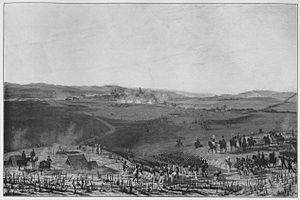Battle of Bar-sur-Aube facts for kids
Quick facts for kids Battle of Bar-sur-Aube |
|||||||
|---|---|---|---|---|---|---|---|
| Part of the War of the Sixth Coalition | |||||||
 The painting shows the movement of the Bavarian foot soldiers in the meeting of Bar-sur-Aube. |
|||||||
|
|||||||
| Belligerents | |||||||
| Commanders and leaders | |||||||
| Strength | |||||||
| 18,000-22,000 60 guns |
27,000-30,000 70 guns |
||||||
| Casualties and losses | |||||||
| 3,100 killed, wounded, or captured 2 guns lost |
1,900 killed, wounded, or captured | ||||||
The Battle of Bar-sur-Aube was a fight that happened on February 27, 1814. It was part of the War of the Sixth Coalition, a big conflict during the Napoleonic Wars. This battle took place in Bar-sur-Aube, a town in France.
The battle was fought between the French army, led by Jacques MacDonald, and a group of armies called the Coalition. The Coalition included soldiers from the Austrian Empire, Kingdom of Bavaria, and Russian Empire. Their main leader was Karl Philipp, Prince of Schwarzenberg. In the end, the Coalition forces won this battle.
Contents
Why the Battle Happened
Napoleon's Strategy
Before this battle, Napoleon I had won a fight at Montereau on February 17. This victory made the Coalition armies retreat. Napoleon then decided to move his main army north. He wanted to stop another Coalition army, mostly Prussians, from moving towards Paris. This Prussian army was led by Field Marshal Gebhard Leberecht von Blücher.
Napoleon left some of his generals behind. He told them to make it seem like he was still with them. This was a trick to confuse the Coalition.
Coalition's Advance
The Coalition commander, Schwarzenberg, decided to test if Napoleon was really gone. He moved his troops towards Bar-sur-Aube. The leaders of Russia and Prussia also wanted him to attack. On February 26, Napoleon ordered his general, Oudinot, to follow Schwarzenberg to Bar-sur-Aube.
The Battle Begins
When the Coalition learned that Napoleon was planning to attack another army, Schwarzenberg saw his chance. He decided to strike first at the French forces under Oudinot. He used a Russian army group led by General Peter Wittgenstein and a Bavarian army group led by General Karl Philipp von Wrede.
French Disadvantages
At the start, the French army had more soldiers. However, many of their troops were separated by the Aube river. This meant they could not join the main fight. Also, much of the French artillery (big guns) was stuck on the wrong side of the river. These problems put the French at a big disadvantage.
After the Battle
After the battle, the French commander, MacDonald, had to retreat across the Aube river. He kept retreating for several days, with the Coalition armies following him. This retreat gave Schwarzenberg a strong position. He was able to gather his forces at Troyes. He also took control of important river crossings on the Seine river.
The Coalition victory at Bar-sur-Aube was an important step. It helped them gain more control in the region.

